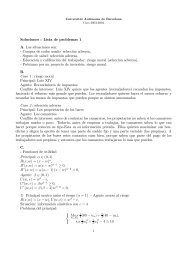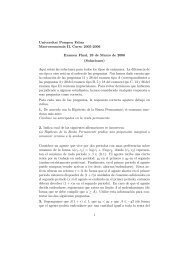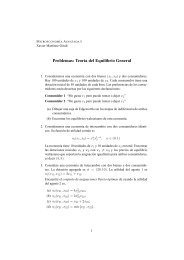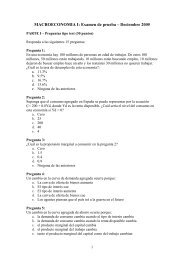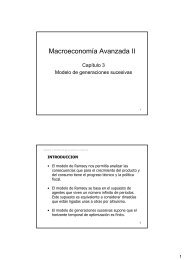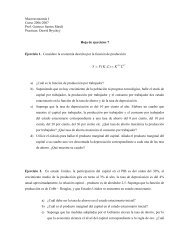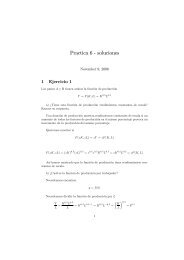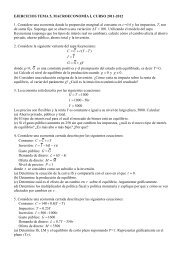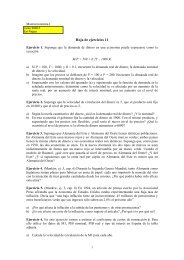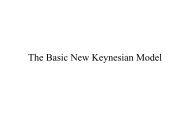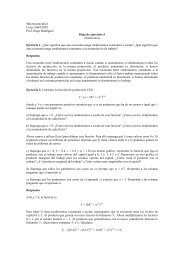Exercise 1 A monopolist has an inverse demand curve given ... - IDEA
Exercise 1 A monopolist has an inverse demand curve given ... - IDEA
Exercise 1 A monopolist has an inverse demand curve given ... - IDEA
You also want an ePaper? Increase the reach of your titles
YUMPU automatically turns print PDFs into web optimized ePapers that Google loves.
c) Socially optimal price: p = MC ⇒ p = 20<br />
d) Socially optimal output: 20 = 100 − 2y ⇒ y = 40<br />
e) deadweight loss: 1(p 2 M −p C )×(y C −y M ) = 0.5(60−20)×(40−20) = 400.<br />
The deadweight loss is 400 euros.<br />
f) Perfect discrimination deadweight loss: 0. Remember that perfect<br />
discrimination me<strong>an</strong>s that the <strong>monopolist</strong> charges a price for each consumer<br />
<strong>an</strong>d charges at the highest willingness to pay of the consumer. He produces<br />
a level of output up to a point where the price is equal to the marginal cost<br />
as in the competitive case, all the surplus going to the <strong>monopolist</strong>. At the<br />
marginal point he sells to the consumer who <strong>has</strong> the lowest willingness to pay,<br />
there is no surplus made on this consumer. In the competitive case, there is<br />
a unique price for all the consumers. At this unique price, some consumers<br />
are happy because they would be willing to pay more for the good. The<br />
producer loses the surplus to the benefit of those consumers.<br />
<strong>Exercise</strong> 3<br />
Consider a market for a homogeneous good with two firms <strong>an</strong>d dem<strong>an</strong>d<br />
function:<br />
Y = 30 − 3p (1)<br />
where Y = y 1 + y 2 . Suppose the firms have the following cost functions:<br />
C(y 1 ) = 3y 1<br />
C(y 2 ) = 4y 2<br />
a) Suppose the two firms engage in Cournot competition. Find the two<br />
reaction functions <strong>an</strong>d graph them.<br />
b) Find the equilibrium price, the qu<strong>an</strong>tities produced by each firm as<br />
well as each firm’s profits.<br />
c) Suppose the two firms engage in Stackelberg competition, where firm 1<br />
acts first <strong>an</strong>d firm 2 acts when firm 1 qu<strong>an</strong>tity is known. Find the equilibrium<br />
price, the qu<strong>an</strong>tities produced <strong>an</strong>d each firm’s profits.<br />
d) Suppose the two firms engage in Bertr<strong>an</strong>d competition. Find the<br />
equilibrium price of each firm, as well as qu<strong>an</strong>tities produced <strong>an</strong>d profits.<br />
e) Suppose the two firms form a cartel <strong>an</strong>d maximize joint profits. Find<br />
the equilibrium price <strong>an</strong>d the qu<strong>an</strong>tities produced by each firm.<br />
Answers<br />
a)Y = 30 − 3p ⇒ y 1 + y 2 = 30 − 3p ⇒ p = 10 − 1(y 3 1 + y 2 )<br />
profit function π 1 (y 1 , y2) e = p(y 1 +y2)y e 1 −C(y 1 ) = [10− 1(y 3 1 +y2)]y e 1 −3y 1<br />
⇒ π 1 (y 1 , y2) e = 7y 1 − 1 3 y2 1 − 1y 3 1y2<br />
e<br />
Profit-maximizing output: ∆π 1(y 1 ,y2 e)<br />
∆y 1<br />
= 0 ⇒ 7 − 2y 3 1 − 1 3 ye 2 = 0<br />
Reaction <strong>curve</strong>: y 1 = 10.5 − 0.5y2<br />
e<br />
2



